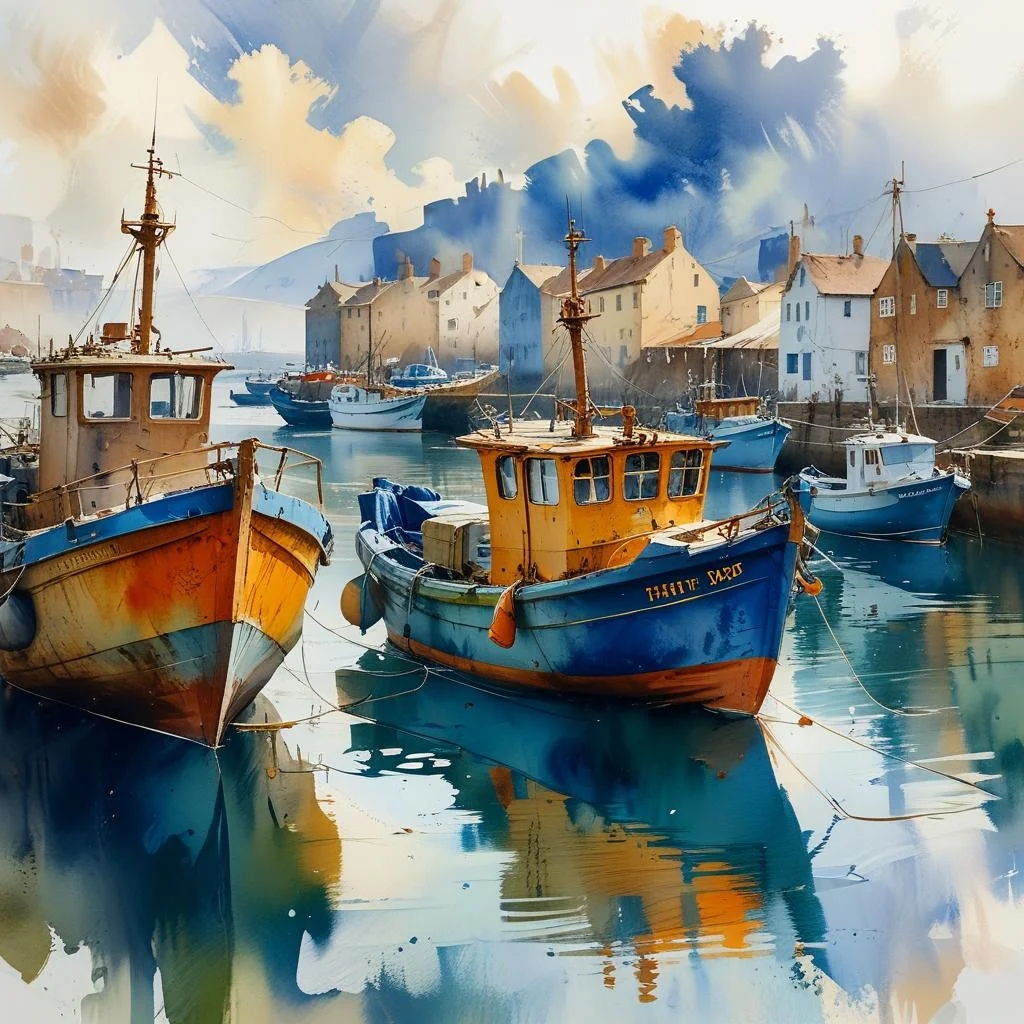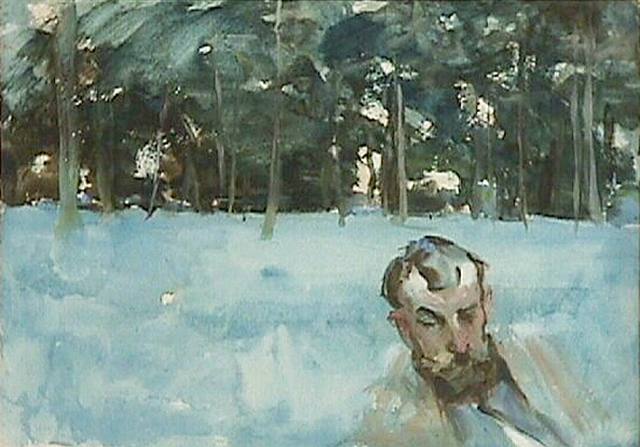When you look at Sandro Botticelli’s famous paintings like The Birth of Venus or Primavera, you’re seeing much more than beautiful art. Every flower, gesture, and color carries a secret message. Symbolism in Botticelli’s paintings reveals a complex world where mythology meets religion, where ancient gods dance alongside Christian ideals, and where every brushstroke tells a story within a story. Understanding these hidden meanings transforms how we experience these Renaissance masterpieces and helps us appreciate why Botticelli remains one of history’s most fascinating artists.
Key Points Summary
- Botticelli used layered symbolism combining mythology, religion, and philosophy
- The Birth of Venus represents divine beauty and Neoplatonic ideals through symbolic elements
- Primavera contains nine figures, each with specific allegorical meanings
- Religious symbolism appears even in mythological scenes, reflecting Renaissance humanism
- Color, gesture, and composition all carry symbolic weight in Botticelli’s artistic language
The Language of Symbols in Renaissance Art
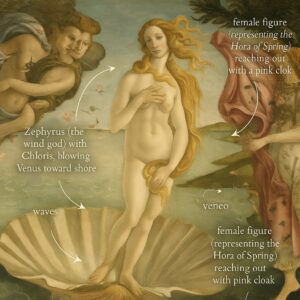
During the Italian Renaissance, artists didn’t just paint pretty pictures – they created visual encyclopedias packed with meaning. Botticelli mastered this symbolic language like few others. Working in 15th-century Florence, he painted for educated patrons who loved puzzles and hidden messages in their art.
The Renaissance brought together classical mythology, Christian beliefs, and new philosophical ideas called Neoplatonism. This created a perfect storm for symbolic art. Wealthy families like the Medici wanted paintings that showed off their education and sophistication. Renaissance Art: A Beginner’s Guide explains how this cultural movement shaped artistic expression.
Artists like Botticelli learned to speak in symbols because their audience expected it. A simple flower might represent love, purity, or rebirth. A gesture could signal divine inspiration or earthly desire. This wasn’t just decoration – it was communication through visual code.
Decoding the Birth of Venus: Mythological and Philosophical Symbolism
The Birth of Venus might be Botticelli’s most famous work, but it’s also one of his most symbolically rich. Let’s break down what each element really means:
The Scallop Shell
Venus stands on a large scallop shell, but this isn’t just artistic license. In Renaissance symbolism, shells represented:
- Birth and creation (like Venus emerging from the sea)
- Femininity and fertility
- Pilgrimage and spiritual journey
- The protective womb of nature
Wind Gods and Divine Inspiration
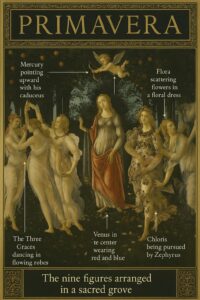
On the left, we see Zephyrus (the west wind) and Chloris blowing Venus toward shore. These aren’t just weather effects – they represent divine inspiration moving through the natural world. The wind symbolizes the breath of life, the spark that animates creation.
Venus’s Pose and the Venus Pudica
Venus covers herself modestly, referencing an ancient sculpture type called “Venus Pudica” (modest Venus). This pose balances sensuality with purity, earthly beauty with divine perfection – a key theme in Neoplatonic philosophy.
Roses in the Air
The roses floating around Venus aren’t random decoration. Red roses symbolized passionate love, while white roses represented pure, spiritual love. Together, they show how Botticelli combined sacred and profane themes.
Quote from art historian Kenneth Clark:
“Botticelli’s Venus represents not the goddess of sensual love, but Venus Coelestis, the goddess of divine love and beauty.”
Primavera’s Hidden Messages: A Garden of Symbolic Meaning
Primavera (also called Allegory of Spring) contains even more complex symbolism in Botticelli’s paintings. This masterpiece features nine figures, each with specific meanings:
| Figure | Position | Symbolic Meaning |
|---|---|---|
| Mercury | Far left | Divine messenger, guide to higher knowledge |
| Three Graces | Left-center | Beauty, charm, and joy in harmony |
| Venus | Center | Love as mediator between earthly and divine |
| Cupid | Above Venus | Blind love and divine inspiration |
| Flora | Right-center | Spring, fertility, transformation |
| Chloris | Far right | Nature being transformed by divine love |
| Zephyrus | Far right | Wind god representing change and inspiration |
The Orange Grove Setting
The background orange trees aren’t just pretty scenery. Oranges were symbols of:
- The Medici family (their coat of arms featured golden orbs)
- Fertility and abundance
- The Garden of Eden
- Eternal spring and renewal
This setting suggests we’re witnessing a sacred space where transformation happens.
The Dance of the Three Graces
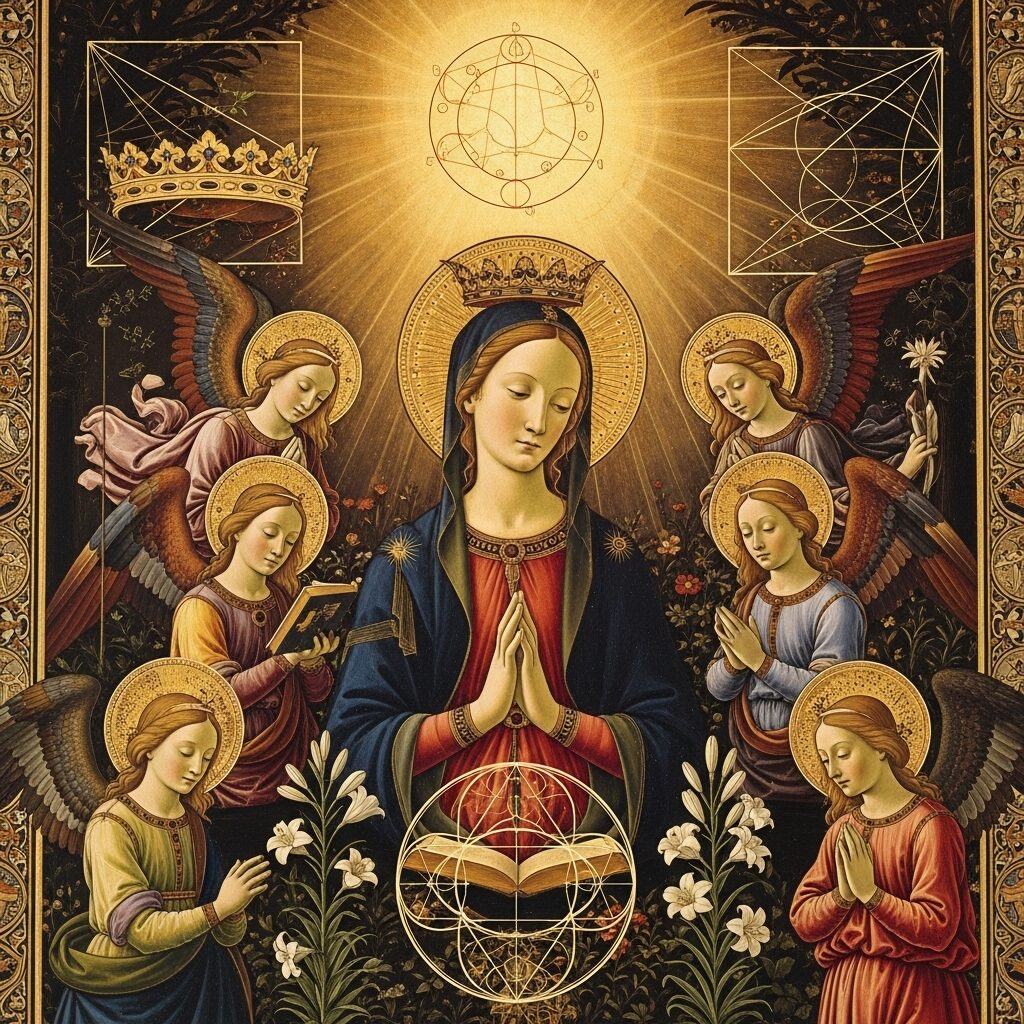
The three dancing women represent different aspects of love and beauty according to Neoplatonic philosophy. Their intertwined hands and flowing movements show how beauty, charm, and joy work together to create harmony.
Religious Symbolism in Botticelli’s Sacred Works
Even in his mythological paintings, Botticelli included Christian symbolism. This wasn’t accidental – it reflected the Renaissance belief that all beauty pointed toward divine truth.
Sacred Geometry
Botticelli often used mathematical proportions considered sacred. The golden ratio appears in his compositions, connecting his work to divine order. Understanding the Meaning Behind Common Art Symbols explores how geometric patterns carry spiritual significance.
Marian Symbolism in Venus
Many scholars see connections between Botticelli’s Venus and the Virgin Mary:
- Both represent pure, divine femininity
- Both are associated with roses and flowers
- Both serve as mediators between heaven and earth
- Both embody the concept of love conquering all
The Influence of Savonarola
Later in his career, the monk Girolamo Savonarola’s religious reforms influenced Botticelli’s work. His later paintings show more obvious Christian symbolism and less mythological content.
The Medici Influence: Political and Cultural Symbolism
The powerful Medici family commissioned many of Botticelli’s works, and their influence shows in the symbolism. Hidden Meanings in Famous Paintings: Unlocking Art’s Secrets in 2025 discusses how patronage affected artistic choices.
Political Allegories
Some experts believe Primavera celebrates a Medici wedding, with specific figures representing family members. The orange trees definitely reference the Medici coat of arms.
Humanist Philosophy
The Medici court embraced humanism, which tried to reconcile classical learning with Christian faith. This philosophical approach explains why Botticelli could paint pagan gods while maintaining Christian themes.
Neoplatonic Philosophy in Botticelli’s Artistic Vision
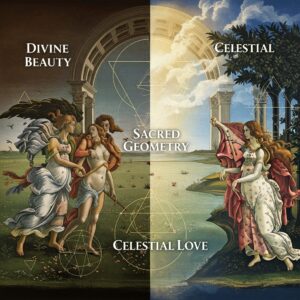
Neoplatonism was a philosophical movement that profoundly influenced symbolism in Botticelli’s paintings. This philosophy, promoted by scholars like Marsilio Ficino, taught that:
- Physical beauty reflects divine beauty
- Love can lift the soul toward God
- All creation is connected through divine love
- Art can reveal spiritual truths
Divine Beauty Theory
According to Neoplatonists, when we see earthly beauty (like Venus), it should inspire us to seek divine beauty. Botticelli’s idealized figures aren’t meant to be realistic – they’re meant to point beyond themselves to perfect, heavenly beauty.
The Ladder of Love
Neoplatonic theory described a “ladder of love” where physical attraction leads to spiritual love, which leads to divine love. Botticelli’s paintings often show this progression through symbolic elements.
Color, Gesture, and Composition as Symbolic Elements
Every technical choice in Botticelli’s paintings carries meaning:
Color Symbolism
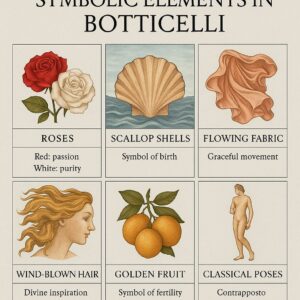
- Gold: Divine light and heavenly glory
- Red: Passion, love, and sacrifice
- Blue: Heaven, truth, and purity
- White: Innocence and spiritual purity
- Green: Nature, rebirth, and hope
Meaningful Gestures
- Pointing upward: Directing attention to heaven
- Open hands: Generosity and divine grace
- Dancing movements: Harmony and cosmic order
- Modest covering: Balance between earthly and divine
Compositional Symbolism
Botticelli arranged his figures according to symbolic principles. Central placement showed importance, while movement patterns guided the viewer’s eye through the painting’s narrative.
Watch this video for deeper insights:
The Legacy of Botticelli’s Symbolic Language
Understanding symbolism in Botticelli’s paintings opens up new ways to appreciate Renaissance art. His work influenced countless later artists who learned to layer meaning into beautiful imagery. Exploring Art Symbolism: A Visual Language Through Time traces how symbolic traditions evolved.
Modern viewers can still connect with Botticelli’s symbolic language because the themes he explored – love, beauty, spiritual longing, and the search for meaning – remain universal. His paintings continue to reward careful looking and thoughtful interpretation, proving that great art speaks across centuries.
When you next encounter a Botticelli painting, remember that you’re looking at a carefully constructed message written in the visual language of symbols. Every element, from the smallest flower to the grandest gesture, contributes to a complex conversation about what it means to be human, to love, and to seek the divine in everyday beauty.
Frequently Asked Questions
What do the symbols in Botticelli’s Birth of Venus represent? The shell symbolizes birth and femininity, the wind gods represent divine inspiration, roses show sacred and profane love, and Venus’s pose embodies divine beauty according to Neoplatonic ideals.
How do you interpret the symbolism in Primavera? Primavera shows Venus as a central mediator, the Three Graces representing beauty and harmony, Flora symbolizing transformation and rebirth, and Mercury as a guide to higher knowledge, all set in a symbolic orange grove.
What religious symbols appear in Botticelli’s paintings? Botticelli included Christian iconography even in mythological scenes, using sacred geometry, Marian symbolism in Venus figures, and divine proportions influenced by his later religious period.
Why did Botticelli combine Christian and pagan symbols? This combination reflected Renaissance humanism and Neoplatonic philosophy, which sought to reconcile classical learning with Christian faith, showing how all beauty points toward divine truth.
What influenced Botticelli’s symbolic style? His symbolic style was shaped by Medici patronage, humanist scholars like Marsilio Ficino, classical literature revival, and the intellectual climate of Renaissance Florence.
How does Botticelli’s symbolism differ from other Renaissance artists? Botticelli’s unique approach combined poetic literary influences, deep Neoplatonic philosophy, and highly personal interpretations of mythological themes, creating more complex layered meanings.
Citations:
- Botticelli’s Mythological Renaissance Art – WikiArt
- Decoding the Allegories in Primavera by Sandro Botticelli – 1st Art Gallery
- The Birth of Venus by Botticelli – Uffizi Gallery
- Sandro Botticelli: The Genius Behind Renaissance Beauty – Understanding Italy
- Identity, Metaphor and Symbol in Botticelli’s Primavera – Academia.edu
- The Hidden Message in Botticelli’s Primavera – Curtisward

